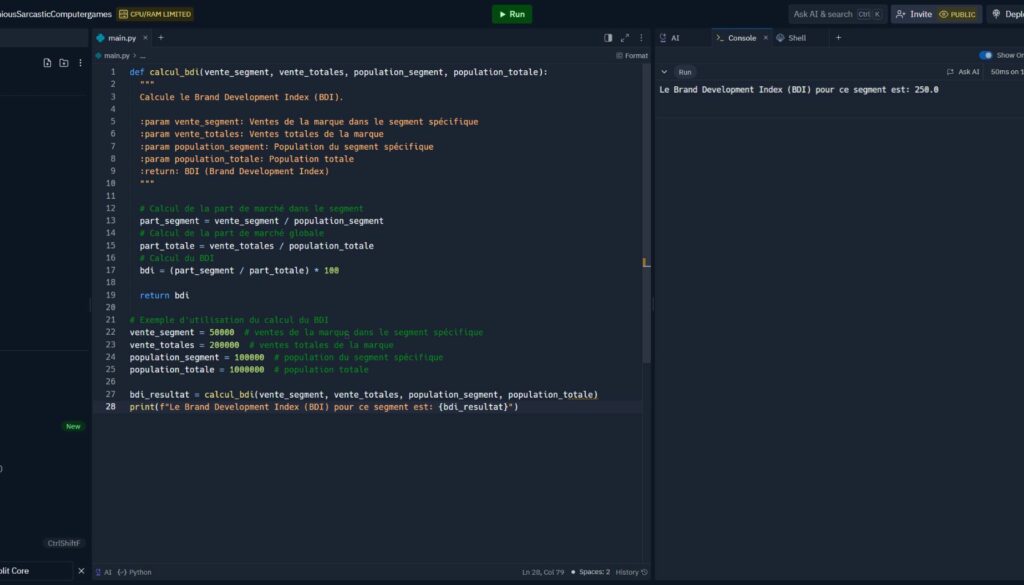Jazz music, with its richness and complexity, has always been a fascinating field for analysis and exploration. This article focuses on the mapping of collaborations between jazz musicians. It is an initiative that goes back over 15 years and aimed to analyze a database of musical recordings stretching from Billie Holiday’s illustrious “Lady Day” to more recent works such as Dave Douglas’s “Soul on Soul” and Pat Metheny’s “Trio 99-00”.
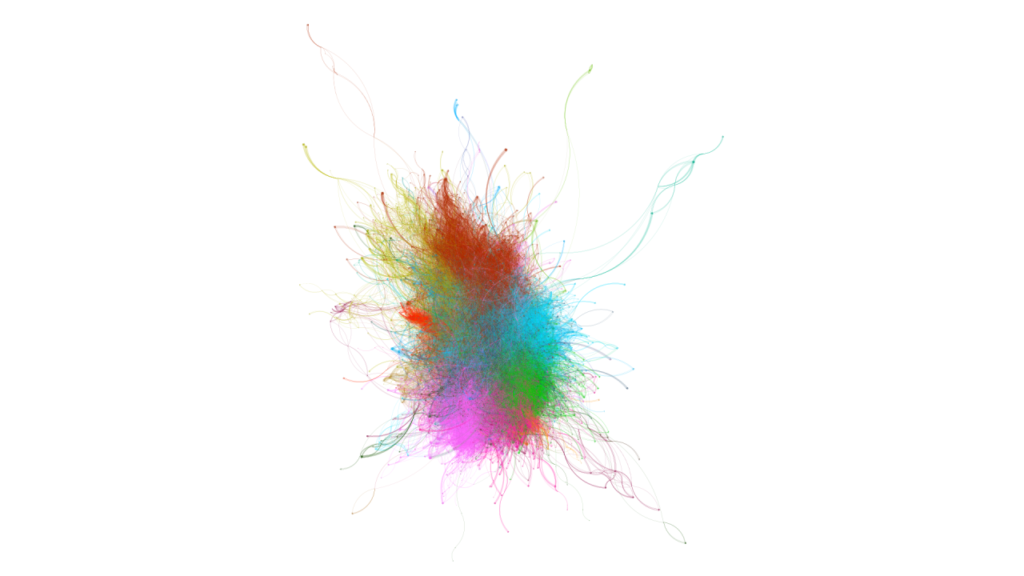
The database
The database covers a significant period in the history of jazz, with recordings from 1935 to 2000. It offers a global perspective on the evolution of the genre, highlighting trends and transitions over time.
The database includes 12,003 recordings and a total of over 16,000 musicians. The database has not been fully cleaned, resulting in the presence of homonyms and writing variants.
The most prolific musicians
Among the treasures in this collection, some artists stand out for their prolific contribution. Oscar Peterson, for example, has 98 albums to his name, closely followed by Sonny Stitt with 85. Miles Davis, Art Blakey, Dizzy Gillespie, John Coltrane, Dave Brubeck, Chet Baker, Bill Evans and Jimmy Smith are also among the most productive.
The most collaborative musicians
Collaboration is an essential component of jazz. In this database, Ron Carter and Ray Brown stand out with 287 and 257 collaborations respectively. Sam Jones, Paul Chambers, Hank Jones, Kenny Burrell, Tommy Flanagan, Oscar Peterson, Clark Terry and Kenny Barron are also central figures in terms of collaboration.

The image is a network graph illustrating the relationships between the top 100 jazz musicians in the database. Each point (or node) in red represents a musician, and each line (or edge) connecting two points represents a relationship between these musicians. The names written next to the points indicate the artists’ identities.
The more lines a musician has starting from his name, the more he has collaborated with other musicians. This can indicate not only a musician’s influence, but also his centrality in the jazz network.
Musicians with the most connections can be considered “hubs” or key connection points in the network. They may have played in many different ensembles or been sought-after band leaders. Less connected musicians could be specialists or session artists who collaborated more selectively.
This mapping can also show sub-groups of musicians who tend to play together regularly, often due to belonging to specific jazz sub-genres or particular eras within jazz history. For example, musicians from the bebop era might be more connected to each other than to those from the swing or jazz fusion eras.
Find out more about the application used for these first networkshttps://onlinelibrary.wiley.com/doi/10.1002/9781118599761.ch9
Miles Davis network analysis (example)
Miles Davis, a legendary jazz trumpeter, was known for his many influential collaborations. The database reveals collaborations with various artists on over 100 albums.
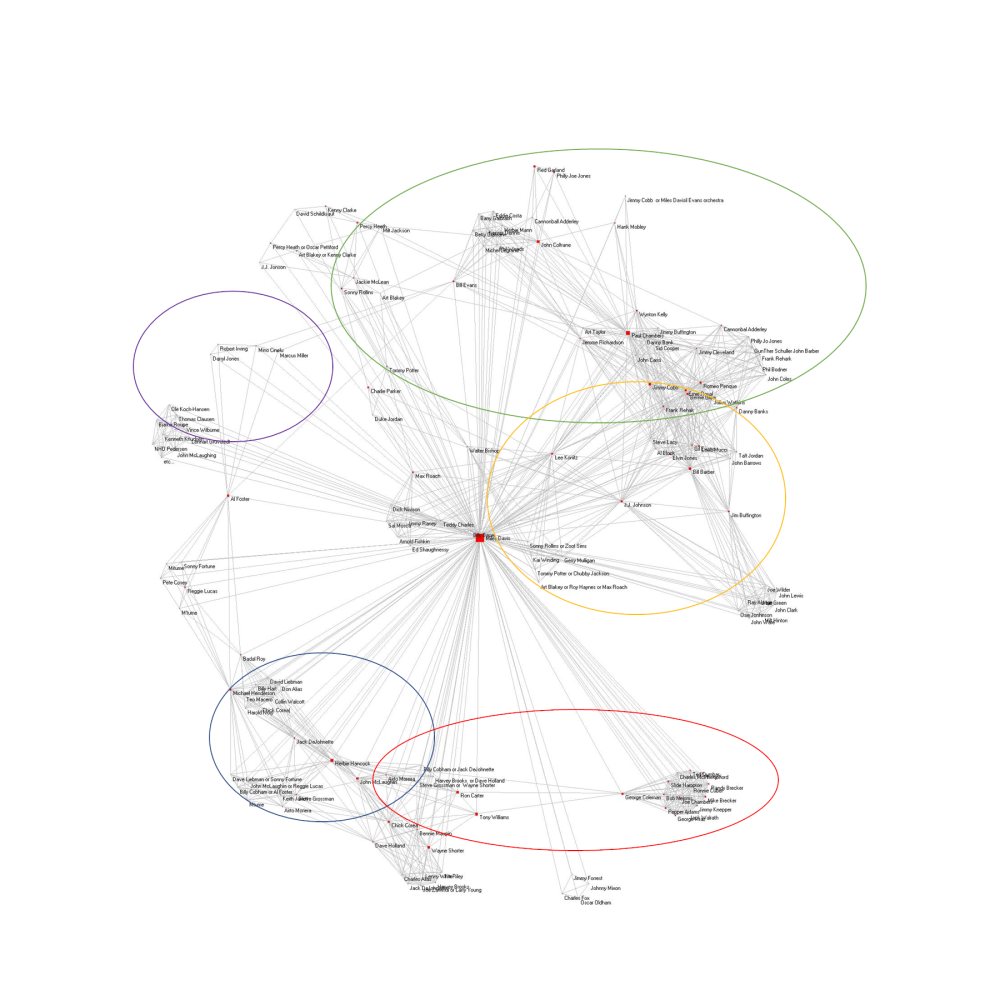
Yellow/orange 1940s: 7 albums, marking the start of his career: Miles Davis collaborates with Kai Winding, Junior Collins, Gunther Schuller, Bill Barber, Al Haig, John Lewis, Al McKibbon, Nelson Boyd, James Moody, Tadd Dameron, Barney Spieler, Howard McGhee, Shorty Rogers…
Green 1950s – 38 albums – Bebop and Birth of Cool Jazz: during this period, Miles Davis collaborated with musicians such as Sonny Rollins, Julian “Cannonball” Adderley, Bill Evans and John Coltrane. These collaborations helped define the sound of modern jazz and paved the way for new musical explorations.
In red the 1960s – 24 albums – transition to modal jazz and the start of the electric era: in the 1960s, Miles Davis turned to modal jazz and began experimenting with electric elements. He worked with musicians such as Herbie Hancock, Wayne Shorter, George Coleman, Chick Corea, John McLaughlin, Keith Jarrett, Tony Williams, Joe Zawinul, Dave Liebman and Kenny Garrett. The discovery of Jimi Hendrix’s music and the shock of the 1969 Newport Festival played a key role in this evolution, leading Davis to become a pioneer of jazz fusion.
In blue the 1970s – 12 albums – Jazz Fusion and Experimentation period: during this period, Miles Davis continued to push the boundaries of jazz, mixing elements of rock, funk and electronic music. His collaborations with previous musicians led to the formation of iconic jazz fusion groups such as Weather Report (Wayne Shorter and Joe Zawinul), Mahavishnu Orchestra (John McLaughlin), Return to Forever (Chick Corea) and various bands led by Herbie Hancock.
Purple 1980s: 6 albums, continuation of jazz fusion and experimentation. Collaboration with musicians such as Mike Stern, Marcus Miller, Sammy Figueroa, Mino Cinelu…
1990s: 1 album, end of career.
Mapping applications in the music industry
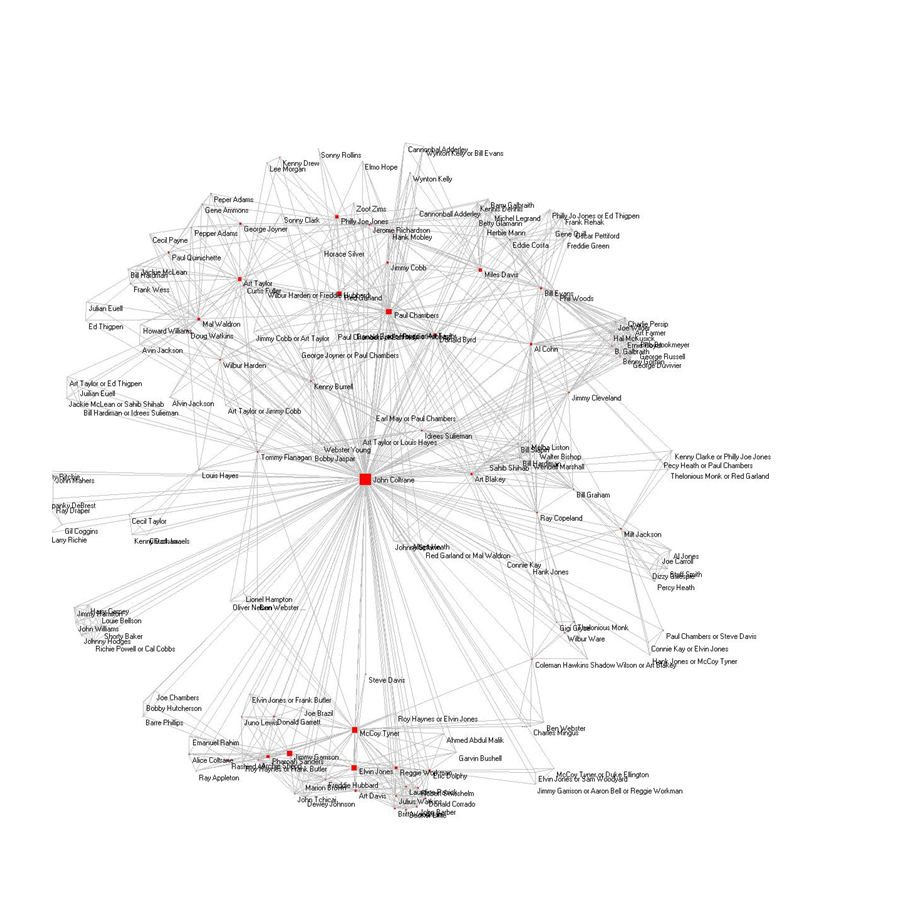
The study of this mapping offers insights for various players in the music industry. Record companies can use it to identify the most prolific and collaborative artists, agents and promoters to plan attractive events, and streaming platforms to refine their music recommendations.
Artists, composers and artist managers can also benefit from this mapping. It enables them to identify potential collaboration partners, monitor musical trends, and develop informed career strategies.
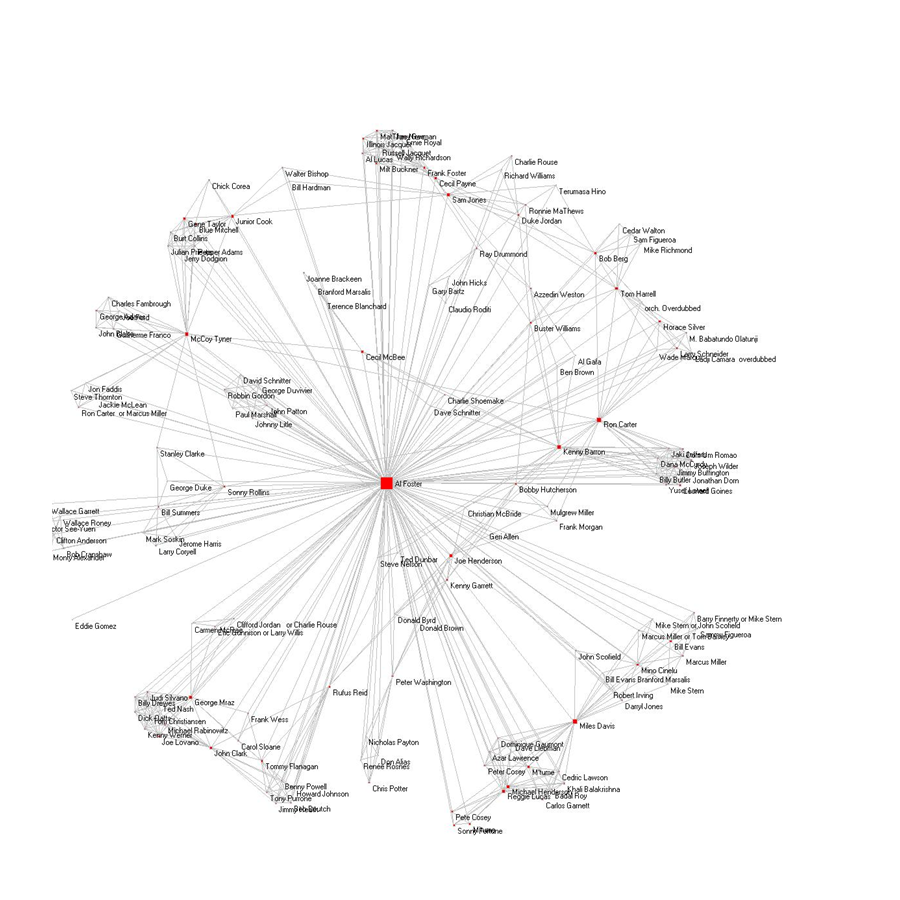
Beyond music professionals, this mapping can be invaluable to music publishers, recording studios and jazz enthusiasts. It helps manage catalogs and copyrights, target potential projects and discover new artists and musical trends.
Other sectors: Partnerships, Research, Marketing, HR
Data mapping is not limited to the music industry. It also offers interesting prospects for companies and professionals in a variety of fields, from the analysis of business collaborations to human resources management. In this article, we present the multiple applications of mapping, demonstrating how it can be a valuable tool for improving market understanding, optimizing operations and making more informed decisions. In doing so, we attempt to highlight its versatility in the world of business and research. Here are some potential applications:
Collaboration and partnership analysis: in the same way that musicians have collaborated on albums, companies can analyze collaborations and partnerships with other companies to identify the most frequent and productive partners. This can help strengthen strategic business relationships.
Analysis of research trends: as in the case of mapping jazz recordings over a given period, it is possible to analyze research trends over time by examining published articles. This allows us to identify emerging research topics and areas that have gained or lost importance over the years.
In the field of research, it is also interesting to analyze the configuration and evolution of a laboratory or research institute, based on an exploration of their publications, or the positioning of research institutes in an international perspective.
Analysis of interdisciplinary collaborations: by examining collaborations between researchers from different disciplines, we can identify emerging interdisciplinary fields.
Time trend analysis: companies can analyze historical data to identify trends over a given period, and use this information to guide future decisions.
Talent and human resources management: companies can use similar data to assess employee contribution and collaboration, identify key skills and training needs, and make informed talent management decisions.
Fighting fraud: data mapping is also a powerful tool in the fight against fraud. The subject is becoming more complex. In a security context, AI applied to web mapping and SNA can detect abnormal or dangerous behavior, such as the propagation of fake news or cybercriminal activity.
Other applications: media analysis, controversy mapping and textual analysis
Conclusion
Through the various examples, we have shown how data mapping can help companies to better understand their data, identify trends and make more informed decisions in a variety of areas, from partnership management to human resources management, to improving data quality.
Right from the data de-duplication and cleansing phase, the integration of AI is a considerable asset.
Broadening the integration of AI into web mapping and SNA opens up exceptional prospects for analyzing, understanding and interacting with social networks, impacting multiple aspects of modern society.



